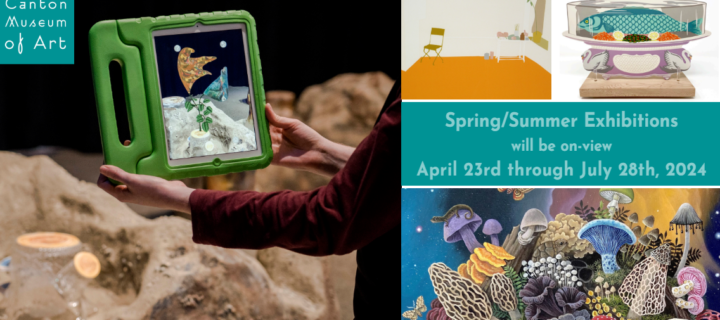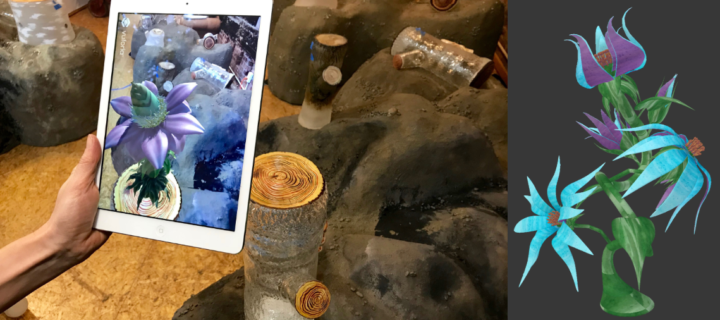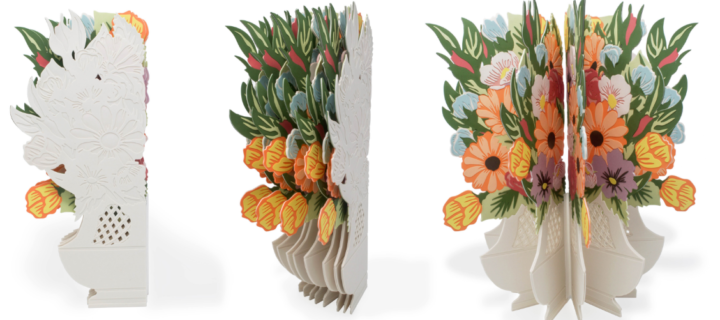
Featured Gallery Exhibitions

Ginny Ruffner: Reforestation of the Imagination
In this traveling exhibition from the Renwick Gallery of the Smithsonian American Art Museum, internationally renowned artist Ginny Ruffner creates a seemingly bleak environment that suddenly evolves into a thriving floral oasis by combining traditional sculpture with augmented reality (AR) technology. In collaboration with animator and media artist Grant Kirkpatrick, Ruffner brings to life a colorful world where glass stumps suddenly sprout mythical flora that have adapted to their surrounding conditions in unexpected, beautiful and optimistic ways. By transforming the CMA lower galleries into a multidimensional experience, Ginny Ruffner: Reforestation of the Imagination calls into question the very notions of reality and fantasy, of concrete and abstract, and of desolation and hope.Ginny Ruffner is among a vibrant group of artists bringing AR to museum installations. By using this technology as another art media, she transforms visitor experiences. Robyn Kennedy, chief administrator at the Renwick Gallery, coordinated this presentation of the installation, which was first shown at MadArt Studio in Seattle in 2018.
The installation consists of landmasses featuring intricate handblown glass sculptures of tree stumps, with painted tree rings that function as discrete QR codes. These islands surround a landmass that supports a large fiberglass stump sprouting beautifully grotesque bronze and glass appendages. Other than the central stump and the painted shelf mushrooms and tree rings on the surrounding stumps, the scene appears colorless and desolate; however, when viewed through AR’s technological lens an alternate landscape is revealed.
Visitors can download the free app “Reforestation” on their phones or use the iPads in the gallery to bring this second reality to life. When the tree rings of a stump are viewed through the device’s camera lens, a hologram of a fictional plant appears to sprout from the sculpture. These imagined fruits and flowers have evolved from existing flora, developing dramatic appendages and skills necessary to flourish in this radically different environment. In this reality, tulips develop stem flexibility, pears contain windows to the outside world and flowers take on the form of birds. The installation includes Ruffner’s tongue-in-cheek descriptions of her fanciful flora and their remarkable, sometimes humorous adaptations, as well as 19 original drawings by the artist that were the inspiration for the AR images.
Ruffner is based in Seattle and trained at the University of Georgia, graduating with a master’s degree in fine arts in drawing and painting. She is an artist best known for her elegant sculptures and mastery of glass techniques. Ruffner has had more than 85 solo exhibitions, and several hundred group shows, and her artwork can be found in numerous national and international collections. Ruffner has also lectured and taught extensively and has served as artist-in-residence at schools and universities around the world.
Kirkpatrick, also based in Seattle, received a master’s degree in fine arts from the Cornish College of the Arts and is an emerging animator and new-media artist. His interests include the intersection of art and technology, particularly VR/AR, game design and mixed-media work.
Artworks courtesy of Ginny Ruffner Studio dated 2017. Tree stumps are handblown glass with acrylic paint tree rings; “island” supports are plywood, low-density foam, fiberglass, epoxy, sand, pebbles, and acrylic paint; drawings are watercolor, pencil, and image transfer on paper.
Ginny Ruffner: Reforestation of the Imagination is organized by the Renwick Gallery of the Smithsonian American Art Museum. Generous support for this exhibition is provided by Art Bridges, the Smithsonian American Women’s History Initiative, Elizabeth and James Eisenstein, Ed and Kathy Fries, Shelby and Frederick Gans, James Renwick Alliance, Colleen and John Kotelly, Betty and Whitney MacMillan, Jacqueline B. Mars, Kim and Jon Shirley Foundation, and Myra and Harold Weiss.

A Material World: Janice Jakielski’s Impossible Objects
Janice Jakielski was born in a small farm town in the heart of Pennsylvania Dutch country. Her innovative work in clay utilizes new ways of casting and manipulating ultra-thin porcelain sheets that leave the viewer wondering how it was made. Jakielski creates impossible objects of curiosity and beauty that provide focus, retreat and pause in an overwhelming world. Using meticulous detail, familiar forms and uncertain function she coaxes her audience to draw near, closing the physical gap between viewer and object. In this way the details of workmanship and the excessive fragility of the porcelain act as a whisper, flirtatiously demanding investigation.
Jakielski uses colored clay materials mixed with binders and plasticizers. It is clay with a paper quality and remains workable over a long period of time. When fired, the non-clay materials fire out, leaving only the colored porcelain behind. Jakielski and her husband, who is a ceramic engineer, have a patent pending on their unique process termed “thin-cast porcelain”.

Beyond Worlds: Paintings by Laine Bachman
As a young child growing up in a once flourishing town in the Rust Belt of Ohio, Laine Bachman always had an affinity towards drawing and painting. Her parents encouraged her creativity from the beginning which led to her attending art school in nearby Columbus, receiving a BFA from the Columbus College of Art and Design in painting in 1997.
Often inspired by myths and folklore, Bachman infuses the worlds she creates with archetypal imagery, underlying themes, decorative motifs, and meticulous details. Working in watercolor and acrylics, her paintings are full of creatures and landscapes, real or imagined, that are all part of the larger story behind her work. Bachman’s work, recognized as Magical Realism, is greatly influenced by Henri Rosseau and his flat, lush, and detailed landscapes and also by surrealist Frida Kahlo.
Representations of life, death, beauty, innocence, and evil are depicted in Bachman’s work. Whether it’s animals, insects, birds or favored objects, they become symbols of different expressions. As owls are a symbol for wisdom or butterflies can represent a transformation, it’s this kind of idea behind the creatures that helps them tell a part of the whole story.
The works expose unique environments in which to explore and pay homage to the various forms of life that Bachman finds fascinating and mysterious in nature. Vast landscapes are used to showcase these life forms, showing the spaces between and the surfaces above and below. The worlds she creates are hidden and untouched by man and give the viewer a glimpse into the secret lives of their peculiar inhabitants.

Immersive Spaces: From the CMA Collection
Art has the unique ability to pull us in and take us away to new places. Take an ocean scene, for example — the light dancing off the water, the sun on your skin, the sound of crashing waves, the smell of salt in the air — these are things that might come to mind when looking at such a work, transporting you there.
Artwork activates all of our senses when we imagine ourselves stepping into it. This occurs through a process known as embodied cognition, in which mirror neurons in the brain turn things you see in art into actual emotions you can feel. The more you analyze a piece of art, the more you place yourself within the scene and feel like you’re part of it.
Immersing yourself in art has various benefits and actually changes your brain. The more time you spend examining a work of art, the more you are able to stimulate both unconscious and conscious brain functions, increasing your analytical and problem-solving skills. Viewing art can also have a profound impact on our well-being and conjure emotional responses. Studies show that it can lower stress and make us feel good: looking at a work of art can increase blood flow to the brain by as much as 10% — the equivalent of looking at someone you love.
These scenes from our Collection have been chosen based on their immersiveness and ability to transport you, as the viewer, to another place.
Exhibitions, Programming, and Operating Support
The Canton Museum of Art’s exhibitions, related programs, and operations are made possible in part through generous support from Arts In Stark, Visit Canton, Stark Community Foundation, The Hoover Foundation, The Paparella Family Foundation, the Canton Museum of Art Exhibition Endowment at Stark Community Foundation, and the Ohio Arts Council, as well as the National Endowment for the Arts and Institute of Museum and Library Services. CMA FREE Thursdays, offering free admission all day, is generously sponsored by PNC Foundation.
About Canton Museum of Art
Recognized for powerful original exhibitions and national touring exhibitions focused on American art and its influences, the Canton Museum of Art makes the discovery and exploration of art accessible to all. The Museum’s education outreach programs, School of Art classes, and workshops serve thousands of students of all ages. CMA’s acclaimed Collection focuses on American works on paper, primarily watercolors, and contemporary ceramics. The CMA Shop (formerly known as the Artisan Boutique) is open during regular Museum hours. Founded in 1935, CMA serves more than 45,000 visitors each year. Visit cantonart.org and follow the Museum on Facebook for updates or call 330.453.7666 for more information.
